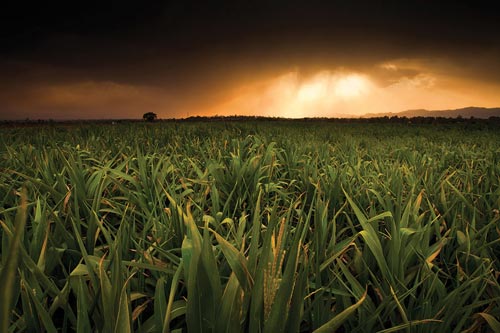Global demand for food is expected to grow rapidly leading up to 2050, and the ability to meet such demand is of the utmost importance in order to maintain food security. However, a recent study shows projected climate change threatens to compromise the world’s ability to meet this demand – especially in global cereal yields – as soon as the next 10 years, given that the bulk of the demand will occur in the next two decades.
The authors emphasize the importance of this information for organizations that deal in international food prices, stability and peace. The study “Getting caught with our plants down: the risks of a global crop yield slowdown from climate trends in the next two decades,” published in Environmental Research Letters by David Lobell, an associate director at Stanford University’s Center on Food Security and the Environment, and Claudia Tebaldi, a research scientist at the National Center for Atmospheric Research, used computer models to examine the potential impact of climate change on food yields in the next 20 years, particularly of wheat and maize.

The models combined global climate trends with data on weather patterns and crops in order to estimate the likelihood that global agriculture would be able to keep up with increased demand under a changing climate. According to the study, under natural climate shifts the likelihood that agricultural production will take a downturn in the next 20 years is very low, but when projected climate change is factored into the equation the results are quite different. “Climate change has substantially increased the prospect that crop production will fail to keep up with rising demand in the next 20 years,” stated Tebaldi. The study found that “because of global warming, the chance of climate trends over a 20-year period causing a 10 percent yield loss has increased from a less than 1 in 200 chance arising from internal climate variability alone, to a 1 in 10 chance for maize and 1 in 20 chance for wheat.” Maize faces a greater threat from climate change than wheat due to the fact that its main production areas are more geographically concentrated, meaning that “large regional trends can have more influence on global maize than wheat.” It is important to remember that one of the major assumptions of the study is that methods to adapt to climate change are not implemented on a large scale in the next 20 years, i.e. “the locations and seasons of maize and wheat production do not change.”
The study suggests that shifting production to cooler regions could help to offset the impacts of climate change on yield, but implies that at the present moment these shifts “are not occurring fast enough to significantly alter the global pattern of maize or wheat production.” While the likelihood of climate change having a devastating impact on wheat and maize yields is not very high, at one in 10 and one in 20 respectively, it is a concern that the odds are considerably higher under “human-induced global warming” than under “natural climate shifts.” It is for this reason that the authors recommend that anyone concerned with food security or international stability be aware of the potential risk climate change poses to global food production. The full article is available at IOPscience.
 Climate adaptation and mitigation
Climate adaptation and mitigation 
